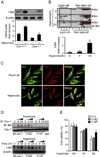Caveolin-1 mediates Fas-BID signaling in hyperoxia-induced apoptosis
- PMID: 21382479
- PMCID: PMC4134776
- DOI: 10.1016/j.freeradbiomed.2011.02.031
Caveolin-1 mediates Fas-BID signaling in hyperoxia-induced apoptosis
Abstract
Fas-mediated apoptosis is a crucial cellular event. Fas, the Fas-associated death domain, and caspase 8 form the death-inducing signaling complex (DISC). Activated caspase 8 mediates the extrinsic pathways and cleaves cytosolic BID. Truncated BID (tBID) translocates to the mitochondria, facilitates the release of cytochrome c, and activates the intrinsic pathways. However, the mechanism causing these DISC components to aggregate and form the complex remains unclear. We found that Cav-1 regulated Fas signaling and mediated the communication between extrinsic and intrinsic pathways. Shortly after hyperoxia (4 h), the colocalization and interaction of Cav-1 and Fas increased, followed by Fas multimer and DISC formation. Deletion of Cav-1 (Cav-1-/-) disrupted DISC formation. Further, Cav-1 interacted with BID. Mutation of Cav-1 Y14 tyrosine to phenylalanine (Y14F) disrupted the hyperoxia-induced interaction between BID and Cav-1 and subsequently yielded a decreased level of tBID and resistance to hyperoxia-induced apoptosis. The reactive oxygen species (ROS) scavenger N-acetylcysteine decreased the Cav-1-Fas interaction. Deletion of glutathione peroxidase-2 using siRNA aggravated the BID-Cav-1 interaction and tBID formation. Taken together, these results indicate that Cav-1 regulates hyperoxia/ROS-induced apoptosis through interactions with Fas and BID, probably via Fas palmitoylation and Cav-1 Y14 phosphorylation, respectively.
Copyright © 2011 Elsevier Inc. All rights reserved.
Figures







Similar articles
-
p62 sequestosome 1/light chain 3b complex confers cytoprotection on lung epithelial cells after hyperoxia.Am J Respir Cell Mol Biol. 2013 Apr;48(4):489-96. doi: 10.1165/rcmb.2012-0017OC. Am J Respir Cell Mol Biol. 2013. PMID: 23333919 Free PMC article.
-
Flotillin-2 modulates fas signaling mediated apoptosis after hyperoxia in lung epithelial cells.PLoS One. 2013 Oct 18;8(10):e77519. doi: 10.1371/journal.pone.0077519. eCollection 2013. PLoS One. 2013. PMID: 24204853 Free PMC article.
-
Hyperoxia-induced LC3B interacts with the Fas apoptotic pathway in epithelial cell death.Am J Respir Cell Mol Biol. 2012 Apr;46(4):507-14. doi: 10.1165/rcmb.2009-0415OC. Epub 2011 Nov 17. Am J Respir Cell Mol Biol. 2012. PMID: 22095627 Free PMC article.
-
Fas death receptor signalling: roles of Bid and XIAP.Cell Death Differ. 2012 Jan;19(1):42-50. doi: 10.1038/cdd.2011.121. Epub 2011 Sep 30. Cell Death Differ. 2012. PMID: 21959933 Free PMC article. Review.
-
Signaling of cell death and cell survival following focal cerebral ischemia: life and death struggle in the penumbra.J Neuropathol Exp Neurol. 2003 Apr;62(4):329-39. doi: 10.1093/jnen/62.4.329. J Neuropathol Exp Neurol. 2003. PMID: 12722825 Review.
Cited by
-
A Frame-Shift Mutation in CAV1 Is Associated with a Severe Neonatal Progeroid and Lipodystrophy Syndrome.PLoS One. 2015 Jul 15;10(7):e0131797. doi: 10.1371/journal.pone.0131797. eCollection 2015. PLoS One. 2015. PMID: 26176221 Free PMC article.
-
p62 sequestosome 1/light chain 3b complex confers cytoprotection on lung epithelial cells after hyperoxia.Am J Respir Cell Mol Biol. 2013 Apr;48(4):489-96. doi: 10.1165/rcmb.2012-0017OC. Am J Respir Cell Mol Biol. 2013. PMID: 23333919 Free PMC article.
-
HMSCs exosome-derived miR-199a-5p attenuates sulfur mustard-associated oxidative stress via the CAV1/NRF2 signalling pathway.J Cell Mol Med. 2023 Aug;27(15):2165-2182. doi: 10.1111/jcmm.17803. Epub 2023 Jun 29. J Cell Mol Med. 2023. PMID: 37386746 Free PMC article.
-
Interaction of caveolin-1 with ATG12-ATG5 system suppresses autophagy in lung epithelial cells.Am J Physiol Lung Cell Mol Physiol. 2014 Jun 1;306(11):L1016-25. doi: 10.1152/ajplung.00268.2013. Epub 2014 Apr 11. Am J Physiol Lung Cell Mol Physiol. 2014. PMID: 24727585 Free PMC article.
-
Caveolin-1 suppresses tumor formation through the inhibition of the unfolded protein response.Cell Death Dis. 2020 Aug 3;11(8):648. doi: 10.1038/s41419-020-02792-4. Cell Death Dis. 2020. PMID: 32811828 Free PMC article.
References
-
- Ashkenazi A, Dixit VM. Death receptors: signaling and modulation. Science. 1998;281:305–1308. - PubMed
-
- Takahashi T, Tanaka M, Inazawa J, Abe T, Suda T, Nagata S. Human Fas ligand: gene structure, chromosomal location and species specificity. Int. Immunol. 1994;6:1567–1574. - PubMed
-
- Ogasawara J, et al. Lethal effect of the anti-Fas antibody in mice. Nature. 1993;364:806–809. - PubMed
-
- Jones RA, et al. Fas-mediated apoptosis in mouse hepatocytes involves the processing and activation of caspases. Hepatology. 1998;27:1632–1642. - PubMed
Publication types
MeSH terms
Substances
Grants and funding
LinkOut - more resources
Full Text Sources
Other Literature Sources
Molecular Biology Databases
Research Materials
Miscellaneous

